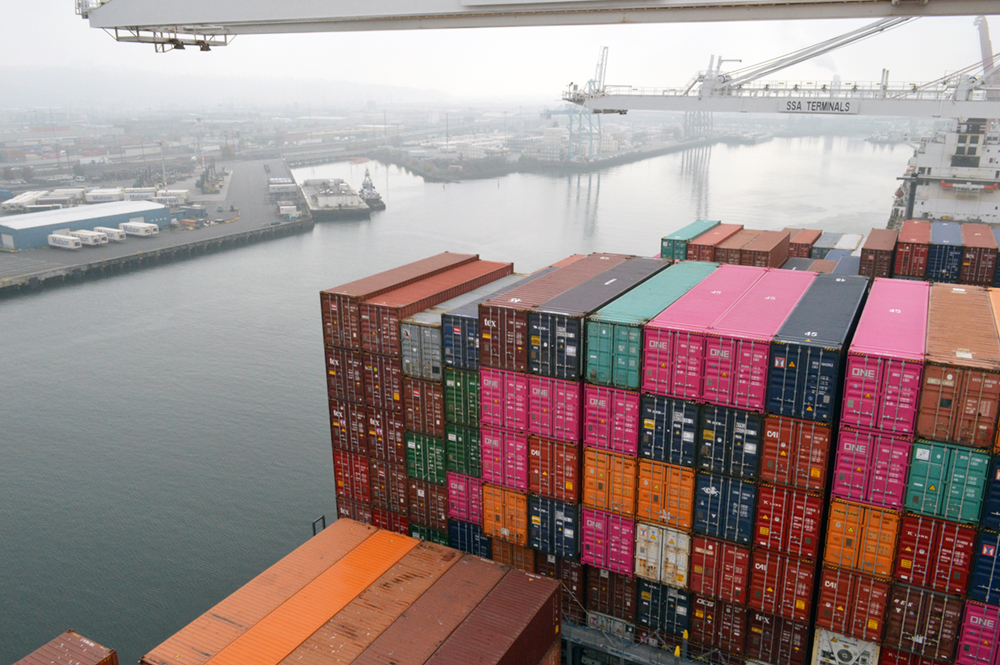By Guthrie Scrimgeour

Port operators in the Pacific Northwest have set a goal to eliminate shipping-related emissions throughout the Georgia Basin-Puget Sound waterway by 2050.
The effort involves the Port of Seattle, Port of Tacoma, Northwest Seaport Alliance container terminals, and the Port of Vancouver. The governing bodies of these four organizations in April formally approved the Northwest Ports Clean Air Strategy 2020, which builds on an earlier clean air plan enacted in 2008.
The updated document calls on the ports to voluntarily reduce air and greenhouse gas emissions in support of the 2050 emissions goal. More detailed port-specific plans to meet that goal will be released in the future, and progress will be charted along the way.
“Ports are a place where a lot of these emissions happen,” said Steve Nicholas, the senior project manager of air quality and sustainable practices for the Port of Tacoma and the Northwest Seaport Alliance. “A lot of big ships are coming into these ports, and we’re using heavy equipment that has been historically diesel-operated.”
“We happen to be an epicenter of emissions,” he said.
Ports, not unlike the ships that call on them, can be a major source of toxic releases. Areas targeted for emissions reductions include oceangoing ships, drayage trucks, cargo-handling equipment, railroad connections, harbor support vessels and port facilities themselves.
According to a 2016 report from the Environmental Protection Agency’s (EPA) Office of Transportation Air Quality, “port-related diesel-powered vehicles, equipment, and ships produce significant [greenhouse gas] emissions that contribute to climate change.”
Fallout from these emissions most severely affect people who live close to ports facilities. These residents “can be exposed to air pollution from diesel engines at ports and be at risk of developing asthma, heart disease, and other health problems.”
Data shows these impacts disproportionately affect poor and minority communities, which are more likely to live be in areas of high pollution, according to the Northwest Ports Clean Air Strategy 2020 plan.
“We recognize that there are certain populations that have borne disproportionate impacts from air pollution, and we recognize that it is very important to eliminate port sources of emissions,” said Alex Adams, interim director of maritime environment & sustainability at the Port of Seattle.
All told, emissions figures from the shipping industry are trending in the wrong direction. According to the International Maritime Organization, greenhouse gas emissions from shipping increased 10% between 2012 and 2018, They are projected to increase by another 50% by 2050 if no additional actions are taken.
“We need to be moving towards zero climate pollution and yet international shipping is projected to actually increase its emissions unless we do something really different,” Nicholas said.
Efforts to cut port-related emissions in these four ports began with adoption of the first clean air strategy in 2008. At the Port of Seattle, one of the first steps toward implementing this plan was introducing two shore-power connections at their cruise terminal in 2009. Cruise ships can connect into the electrical grid rather than run generators.
The electric supply around Seattle incorporates renewable energy, helping to reduce the cruise ships’ emissions to close to zero while docked in the harbor. The port is in the process of installing shore power at their third cruise terminal.
“We see the provision of shore power as the biggest opportunity within our control at our port to reduce emissions from ocean-going vessels,” Nicholas said.
The port also provided an incentive program for cruise ships to use cleaner-burning low-sulfur fuels. Through these programs, the port was able to achieve the previous strategy’s emission-reduction targets about four years early.
Tacoma’s port has instituted adjustments to the cargo-handling equipment, transitioning diesel-powered equipment to cleaner energy sources. They are currently working with one tenant to transition six yard tractors from diesel to fully electric propulsion.
Additionally, they have targeted diesel emissions in their truck fleet, instituting a rule that disallows older, less environmentally friendly trucks from operating in its port. This regulation has seen impacts already, reducing the pollution from their diesel truck fleet by about 9%.
“Obviously, there’s still lots to be done,” Adams said. “But the strategy has really demonstrated that, by working together, we can both stay competitive and get more done.”
While their strategy is based on voluntary participation, representatives of the Pacific Northwest ports agreed that it would be difficult, if not impossible, to reduce shipping emissions without industrywide, mandatory government regulations.
For now, the EPA has taken steps to encourage voluntary portside emissions cuts. The agency’s website, for instance, shows what steps ports have taken to address emissions, such as taking an emissions inventory, setting up targets for emission reductions and initiating government-funded clean air programs.
In California, which has more stringent emissions regulations, major ports in Oakland, Los Angeles, and Long Beach have taken many these recommended steps. Elsewhere in the country, where regulations are less strict, many ports have been slow to adopt these strategies.
“I’m going to come out and flatly say there’s no way these goals can be reached if it is strictly voluntary,” Nicholas said. “We need more from the federal government. We have to remember — this is a competitive industry, and we need to have a level playing field. We’re competing with ports that are doing next to nothing and that gives them an unfair competitive advantage.”
Until these regulations come down, the Pacific Northwest ports can only hope that other shipping hubs will follow their lead.
